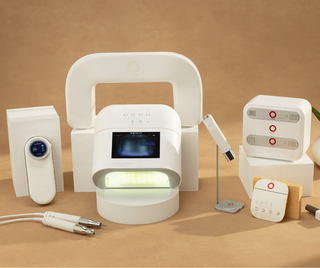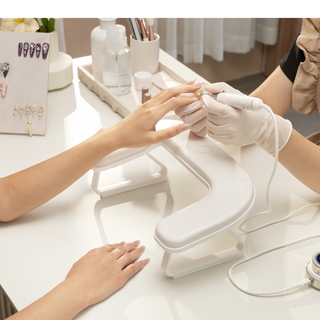Nail polish has become such a staple in our daily lives that at times it can be easy to forget about all that goes into it and how it is made. Luckily, we at take over nail supplies we are here to slow things down for you and take you through all of the main parts and players in any good polish. Knowing this information will be an integral part of your business, as clients are becoming more healthy and safety conscious than ever before.
Give them the service and security they are searching for by getting the low-down on what nail polish is made out of, as well as on some of the popular types these parts combine to create. Keep reading to find out more.
THE PARTS OF POLISH
Depending on the nail polish, there can be many different ingredients and parts that combine to make it into the final and fab product it is. However, when we boil it all down, there are ultimately three main elements that are necessary for the making of all nail polishes.
PIGMENTS
This is one of the most important and integral parts of any nail polish, as this is what ultimately gives each polish its individual color and shade. Pigments are chemicals that can be either organic, carbon cased, or inorganic, like iron oxide.
The pigments that tend to make up nail polish can actually be found in cosmetic products across the board, and include ingredients like ultramarine, titanium dioxide, and carmine.
SUSPENSION BASE
Solvents like ethyl acetate and butyl acetate not only give polishes their distinctive smell, but also help to make up the suspension base, which provides consistency and reliability to nail polishes as they are made.
The suspension base is also what spreads the pigment when the two are mixed to create a solid and consistent color. This element is especially useful for glitter and shimmer polishes because it prevents the individual glitter particles from clumping together or sinking to the bottom of the nail polish bottle.
ADHESIVE POLYMERS
The chemical compound nitrocellulose works as a polymer that dissolves in the solvents to create the filmy adhesive substance that makes nail polish actually stick to where it is applied. Adhesive polymers also help to fortify the nail and prevent it or the polish from chipping.
THE CHEMISTRY OF POLISH
Believe it or not, there is some interesting science that goes into making any and all nail polishes, no matter how seemingly simple or plain they may seem. You and your clients’ favorite nail polish is actually the result of some complex chemistry
We have already touched upon how, when mixed together, pigments, solvents, and film-forming polymers react to form this colored, glossy, and consistent adhesive polymer film that sticks to the fingernail. Additionally, plasticizers like camphor and triphenylphosphate are involved in the process to aid in preventing polish from chipping off or getting cracks.
Other agents like mica and titanium dioxide are used to create a pearly gleaming effect, and stabilizers like benzophenone-1 are also added in to prevent polish from changing color when exposed to light, even after multiple weeks.
As you may expect, gel nail polish is formed slightly differently from your standard polish, with some alternative elements like photoinitiating and methacrylate compounds like benzoyl peroxide.
Due to its different chemical makeup, gel polish does not quickly and easily air dry as conventional nail polish does. Rather, the gel should be applied in layers and put under ultraviolet light after each one to begin a polymerization process that seals the drying process and dries the gel.
POPULAR TYPES OF POLISH
Now that you know more about the important parts of polish, it seems only natural to discuss some of the most popular types that these parts combine to create. Your clients will appreciate that you not only know the ins and outs of how nail polish is made but also that you have a wide variety of polish to choose from
Here are some of the most popular nail polishes out there today.
CHROME
Chrome (also known as metallic) nail polish is packed with shine and sure to catch the eye (and light!) when your client wears it out on the town.
Typically applied in long strokes to avoid streakiness, chrome polish is flashy thanks to its highly reflective nature and can act as the perfect effortlessly glam statement piece or accessory to any outfit and makeup look.
FOIL
Foil polish has been around for years, but only in more recent years has it seemed to catch fire as a popular and sought-after polish in the mainstream, so this is something you will definitely want to have on hand for your clients. It is actually quite similar to chrome polish but ultimately sets itself apart with its extra shine and distinctive texture and appearance.
The “foil” name is a reference to how this polish tends to reflect and catch the light, much like aluminum foil in your kitchens and homes (but much cuter, of course). This is a sleek and futuristic look that is guaranteed to draw the eye and make a statement.
GLITTER
Help people make a statement by directing them to glittery or shimmery nail polish that practically sparkles in the light and sun, making for a fun, playful, and eye-catching appearance any day or time.
Glitter polishes tend to be clear, glossy nail polishes that have pieces of glitter dispersed throughout, spreading on fairly easily (but a little bit of extra work to remove).
Applying a trusted top coat will both seal the sleek and shimmery look while also helping to ensure that it is strong, healthy, and resistant to chipping and peeling.
HOLOGRAPHIC
This fantastically futuristic nail polish is luminous, reflecting any light that strikes it to create that shimmery holographic quality from which it draws its name. Clients looking to make a statement while still sticking with a versatile and dynamic style will absolutely love this polish that even can sometimes change color and appearance depending on how the light hits it.
Holographic polish offers an almost otherworldly quality that completely embraces glamor and glow.
MAGNETIC
A slightly newer trend in the nail polish scene is the magnetic polish, which is definitely a pretty incredible example of the science and endless possibilities of polish in action. Magnetic nail polish begins with the polish in the bottle being applied to your client’s nail before a tiny magnet is used in conjunction with the polish to make various designs and styles.
No need to worry about stocking up on magnets ahead of time since a magnet is usually already built into the polish bottle’s cap, making the whole process simultaneously simple and utterly delightful for both you and your client.
MATTE
Matte nail polish is a distinctive one that is known for its anti-shine and muted finish. Without any shiny film or gloss to be possibly distracting, matte polishes make the client’s chosen color take center stage, creating a sleek, chic, and trendy look full of depth.
This is a unique look that shows off just how cool nail polish can be, and clients looking to experiment in different polish finishes, styles, and designs will definitely want to check this one out.
NEON
Neon is a bright and increasingly popular nail polish look (especially in the summer months!) that serves as a bit of a throwback look while simultaneously acting as a statement for any outfit. Neon polish favors the bold, drawing the eye with the way it can effortlessly pop.
Clients with darker skin tones will find that light shades of yellows, blues, and greens will look especially vivid and vivacious. Meanwhile, clients with lighter skin tones will find a better fit with slightly darker or warmer neon tones in purple and pink for the polish to really pop.
PEARL
Pearl polish gives a delicate and soft look to the fingernail, creating an understated yet effortlessly elegant appearance that fits with just about any outfit or occasion. The versatility of this style is definitely a selling point for clients who want nails that can look classy, chic, and not out of place as they shift from the workplace to a night out in their regular daily lives.
Further customizability is made available with pearl polish by giving your clients the chance to finish off this smooth style with a muted matte or shiny crème top coat to really seal and personalize the look.
IN CONCLUSION
When we see nail polish every day, it is easy to simplify it in our minds and forget how complex it really is. But when we dig a little deeper into how nail polish is made, we see the intricate chemistry that goes into creating the pretty polishes we know and love.
Hopefully, this information has helped to give you and your clients the peace of mind you all deserve as you go into making your latest nail masterpiece, and has also left you with more nail knowledge than you had before.
Sources:





